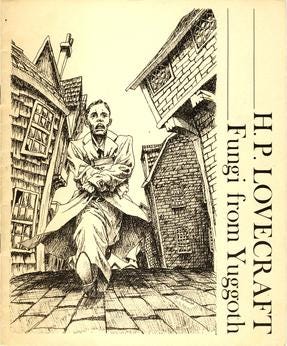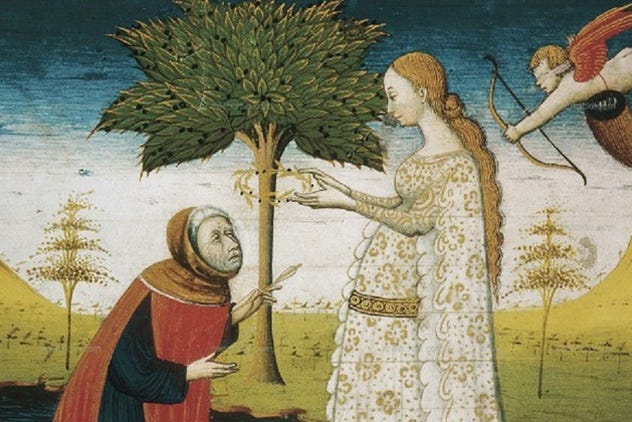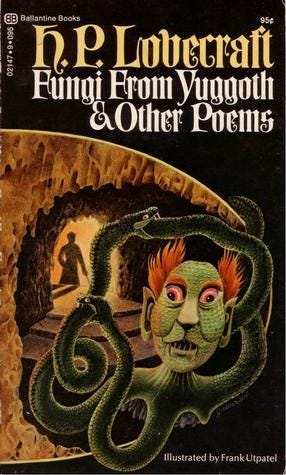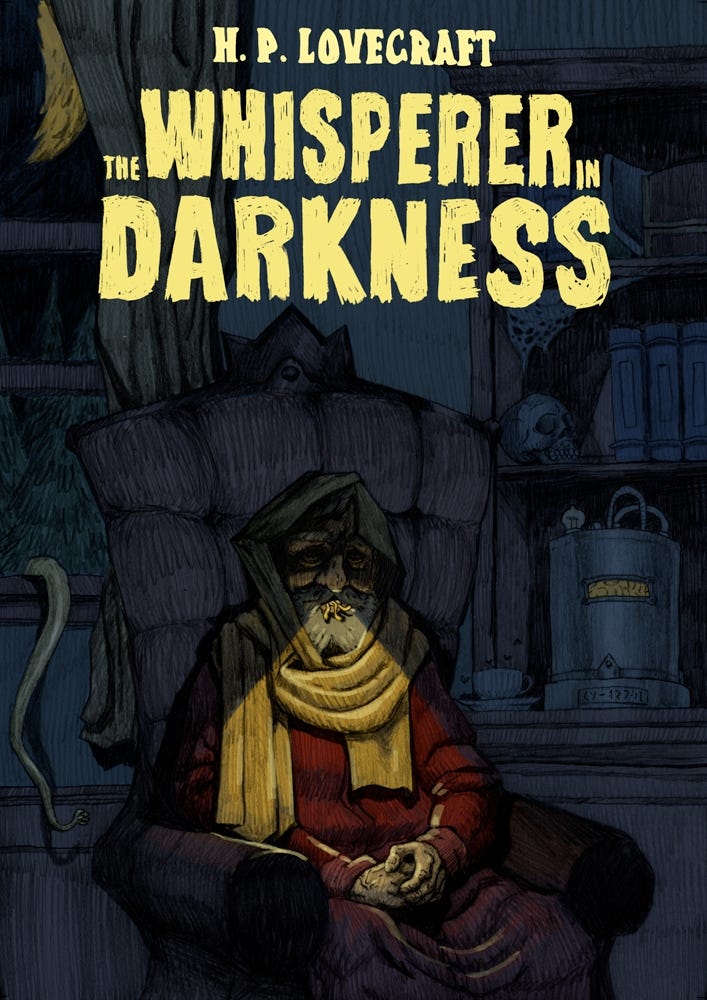Heartbreaking: the Worst Person you Know Just Wrote the Coolest Sonnet Sequence
H. P. Lovecraft's Fungi from Yuggoth (1930)
Note on voiceovers: I’m taking a break from recording voiceovers for a while, partly because I’m freeing up time for a few writing projects and partly because there is some building work happening outside which is making it near-impossible. You can still opt to have them read aloud by ‘the automated voice’...
I was amusing myself one day by trying to find the silliest sounding Lovecraft monster (perhaps that’s a subject for another article) when I came across a reference to something called Fungi from Yuggoth. To my astonishment, I found that this was in fact a sonnet sequence, 36 sonnets long.
I’ve never thought of Lovecraft as a sonneteer, and sonnets are not an obvious form for telling a story like this. I use the word ‘story’ quite loosely since Fungi from Yuggoth is a non-linear nightmare journey through visions of, well, Lovecraftian weirdness.
For those of you who didn’t have to read hundreds of sonnets as an undergraduate, here’s my potted history of the form which is important to understand to fully appreciate how unusual Fungi is. (Scroll down past Marlon Brando if you know all this already).
*ahem*
The sonnet originated in Italy and Sicily where writers like Francis Petrarch primarily used it to convey intense romantic love. It is usually 14 lines long and usually in iambic pentameter. Italian sonnets include a turning point or ‘volta’ after the eighth line where the rhyme scheme changes from ABBAABBA to CDE CDE or CDC CDC. This ‘volta’ usually brings a change in meaning too, as we move from happiness to sorrow, from sorrow to hope and so on.
Sir Thomas Wyatt and Henry Howard, Earl of Surrey brought sonnets like this to England, translating Petrarch’s works and creating their own. Surrey’s great innovation was changing the rhyme scheme so that you have three quatrains with an alternating pattern ABAB CDCD EFEF and then end on a rhyming couplet GG. Now instead of a ‘volta’ just over halfway through, you have more of a punchline effect where the witty epigrammatic couplet right at the end turns the rest of the poem on its head. This is what Shakespeare uses and remains the most popular form of a sonnet in English.
Sonnets were often written in sequences like Sir Philip Sidney’s Astrophel and Stella (1591) which was addressed to the same woman (Stella) by the same man (Astrophel or Astrophil) who desperately wants to win her love. It’s 108 sonnets long plus an additional 11 songs thrown in for good measure and is essentially the Tudor poetic equivalent of that one scene in A Streetcar Named Desire.
Lovecraft’s sequence couldn’t be thematically further from the traditions of the sonnet. Its central theme is …cosmic horror? It’s almost impossible to say precisely what’s going on, but the answer certainly isn’t romance. It’s more like Dante’s journey through Inferno.
To return to that moment when I first discovered the sequence, I have to admit, I was ready to tear it apart. It’s a bunch of sonnets called ‘Fungi from Yuggoth.’ Fungi from Yuggoth! How could it possibly be good?
And then I read the first sonnet.
I. The Book
The place was dark and dusty and half-lost
In tangles of old alleys near the quays,
Reeking of strange things brought in from the seas,
And with queer curls of fog that west winds tossed.
Small lozenge panes, obscured by smoke and frost,
Just shewed the books, in piles like twisted trees,
Rotting from floor to roof—congeries
Of crumbling elder lore at little cost.
I entered, charmed, and from a cobwebbed heap
Took up the nearest tome and thumbed it through,
Trembling at curious words that seemed to keep
Some secret, monstrous if one only knew.
Then, looking for some seller old in craft,
I could find nothing but a voice that laughed.
Oh dear, I thought. I really enjoyed that. Yes it’s overblown, yes it’s bizarre, yes it’s quintessentially Lovecraftian – and what an incredibly innovative use of the form! I had always thought of Lovecraft as more of an ideas guy than a sparkling writer. I’d found some of his prose a bit lengthy and repetitive, and I’ll admit I was predisposed to think poorly of him because of his unpleasant personal views on, for example, race. Putting the man’s morality to one side, let’s a have a closer look at his choices here because it turns out that Lovecraft is a much better writer than I gave him credit for.
To use the poem above as an example, this is a sonnet with a volta structure, like the original Italian Petrarchan sonnets. The first 8 lines are ABBAABBA, and the ‘volta’ here brings both a physical and psychological shift from outdoor to indoor, from curiosity to immersion. I don’t know that I can think of any sonnets that put a literal doorway at the volta like this – it’s a great idea.
But then, oddly enough, we meet a final six lines that don’t follow the Italian schemes of CDE CDE or CDC CDC, as we might expect, but go CDCD EE, ending on a rhyming couplet like a Shakespearean English sonnet. So we get an Italian turning point and an English ‘punch line.’ The ‘punch line’ here is the revelation that some unseen, perhaps bodiless entity has been watching our narrator and is now laughing at him. It completes the mini story of the first sonnet, yet feels like the first footstep of a journey.
No offence to Astrophel and Stella, but you know exactly where romantic sonnets sequences like it are going to end up: pretty much right where they started, with the admiration and fixation of a lover for the object of their desire. I had absolutely no idea where Fungi was headed next, so I sat down and read them all. In one sitting.
And I recommend that you do too. I can’t promise that you’ll be any the wiser for it, and some of you will definitely find it a bit much. Each sonnet feels like its own strange dreamlike scene, and it’s unclear if they form a narrative or a series of vignettes. There are farmers driven insane by something unearthed in a well, a daemon that takes the speaker through a land of nameless gods, strange bells are heard pealing from the ocean floor, we see visions of cities and gardens where no human foot has trod…and fungi from Yuggoth, of course, although apparently only ‘moonstruck poets’ can glimpse them and what they are exactly is never explained. Lovecraft would expand upon their mythology in his later story The Whisperer in Darkness (1931).
In all that bonkers imagery there’s some absolute stunning turns of phrase. Listen to this description of a ‘black cone’ buried at the South Pole:
XV. Antarktos
Deep in my dream the great bird whispered queerly
Of the black cone amid the polar waste;
Pushing above the ice-sheet lone and drearly,
By storm-crazed aeons battered and defaced.
Hither no living earth-shapes take their courses,
And only pale auroras and faint suns
Glow on that pitted rock, whose primal sources
Are guessed at dimly by the Elder Ones.
If men should glimpse it, they would merely wonder
What tricky mound of Nature’s build they spied;
But the bird told of vaster parts, that under
The mile-deep ice-shroud crouch and brood and bide.
God help the dreamer whose mad visions shew
Those dead eyes set in crystal gulfs below!
I don’t know about you but it’s a relief to take a break from the doe-like eyes of beautiful Italian women to hear instead about ‘dead eyes set in crystal gulfs below.’ If Fungi doesn’t win you over to Lovecraft’s worldbuilding, one can surely admire the extraordinary talent required to see beyond the traditional uses of a form and unlock whole new worlds of possibilities that, like an ocean harbouring an ancient god, it turns out it held slumbering all the while.
I still don’t think I’d have liked Lovecraft if I’d met him, he had some truly abhorrent personal views. The thing is, you don’t have to like someone to think they’re a brilliant writer. On the contrary, it’s a testament to his skill that he won over someone who was setting out to mock him. Isn’t that annoying? It’s a bit like that Clickhole joke that became a meme: ‘Heartbreaking: The Worst Person You Know Just Made A Great Point.’
I guess if you love the craft of writing, you’ll love Lovecraft’s craft even if you don’t love Lovecraft.
(Sorry.)
Subscribe for more articles on a range of fascinating subjects. I publish my ‘horror moments’ on Thursdays, and other curious content like this on Mondays.








I like to think, being an incurable optimist, that had I known Lovecraft I would have been able to convince him that his ideas about race were wrong. He had switched in the last years of his life from ultra-conservative to New Deal Democrat, even shading towards socialism (whatever Americans mean by that) and there were some Jewish and Black thinkers whom he had begun expressing approval of. We'll never know, but the sense I get from his friends' accounts was of a fundamentally kind man with some preposterously affected notions acquired from his grandfather and, even more, from his grandfather's library. So given a few more years we might have turned him into a true progressive. Whether anything could have fixed his prose style is another question, though!
Great piece. Though I suspect if you’d met Lovecraft, you actually would have liked him a lot. Despite his reputation (and genuinely terrible views on a range of topics), he seems to have been a garrulous and charming guy. In his correspondence, he definitely seems to be sensitive to whether the person he’s writing to would be offended by one or the other of his crackpottier views and is correspondingly discreet. Also, despite his habit of pulling solemn, po-faced, old-fashioned expressions for the camera, he apparently laughed easily and was quite funny.